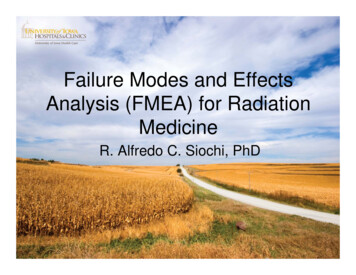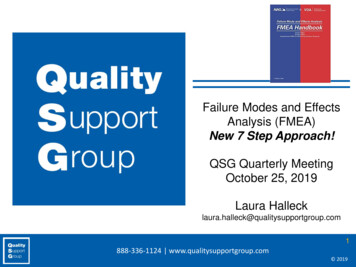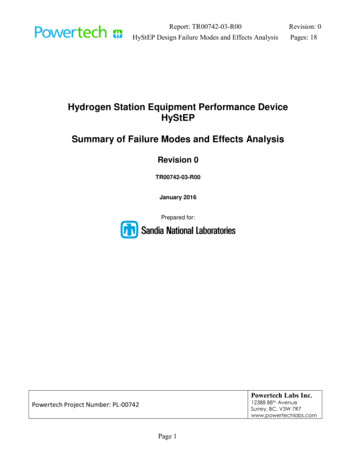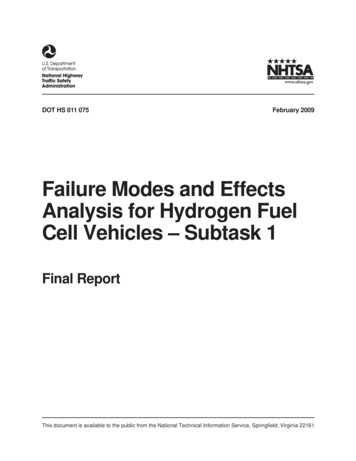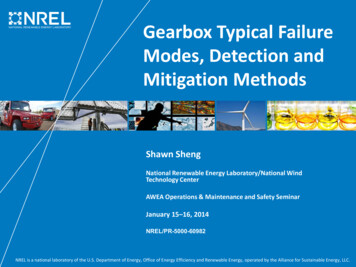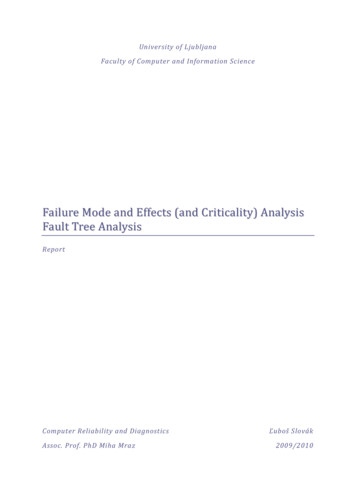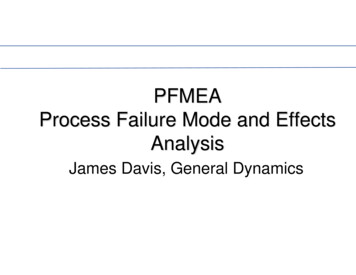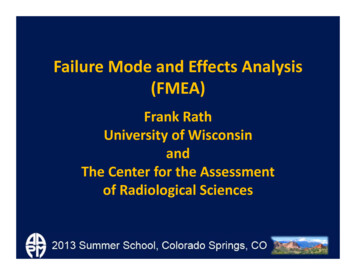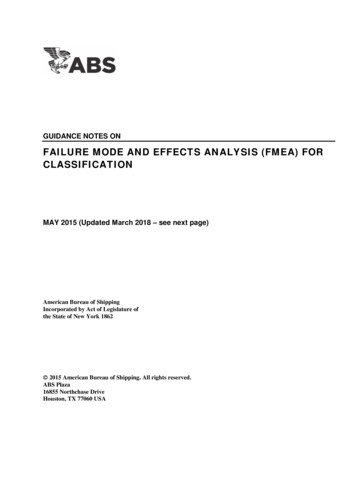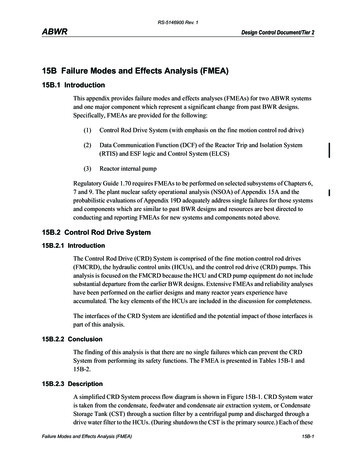
Transcription
RS-5146900 Rev. 1ABWRDesign Control Document/Tier 215B Failure Modes and Effects Analysis (FMEA)15B.1 IntroductionThis appendix provides failure modes and effects analyses (FMEAs) for two ABWR systemsand one major component which represent a significant change from past BWR designs.Specifically, FMEAs are provided for the following:(1)Control Rod Drive System (with emphasis on the fine motion control rod drive)(2)Data Communication Function (DCF) of the Reactor Trip and Isolation System(RTIS) and ESF logic and Control System (ELCS)(3)Reactor internal pumpRegulatory Guide 1.70 requires FMEAs to be performed on selected subsystems of Chapters 6,7 and 9. The plant nuclear safety operational analysis (NSOA) of Appendix 15A and theprobabilistic evaluations of Appendix 19D adequately address single failures for those systemsand components which are similar to past BWR designs and resources are best directed toconducting and reporting FMEAs for new systems and components noted above.15B.2 Control Rod Drive System15B.2.1 IntroductionThe Control Rod Drive (CRD) System is comprised of the fine motion control rod drives(FMCRD), the hydraulic control units (HCUs), and the control rod drive (CRD) pumps. Thisanalysis is focused on the FMCRD because the HCU and CRD pump equipment do not includesubstantial departure from the earlier BWR designs. Extensive FMEAs and reliability analyseshave been performed on the earlier designs and many reactor years experience haveaccumulated. The key elements of the HCUs are included in the discussion for completeness.The interfaces of the CRD System are identified and the potential impact of those interfaces ispart of this analysis.15B.2.2 ConclusionThe finding of this analysis is that there are no single failures which can prevent the CRDSystem from performing its safety functions. The FMEA is presented in Tables 15B-1 and15B-2.15B.2.3 DescriptionA simplified CRD System process flow diagram is shown in Figure 15B-1. CRD System wateris taken from the condensate, feedwater and condensate air extraction system, or CondensateStorage Tank (CST) through a suction filter by a centrifugal pump and discharged through adrive water filter to the HCUs. (During shutdown the CST is the primary source.) Each of theseFailure Modes and Effects Analysis (FMEA)15B-1
RS-5146900 Rev. 1ABWRDesign Control Document/Tier 2components is independently redundant and only one of each is in operation at any one time. Aportion of the pump discharge flow is diverted through a minimum flow bypass line to the CST.The pumped water is directed to the HCU to provide hydraulic scram and to furnish purging tothe drive. This system also provides purge water for the reactor internal pumps, nuclear boilerinstrument lines, and the reactor water cleanup pumps.The HCUs are all supplied by the same operating CRD pump, but the HCUs are divided intofour banks, A & D on one side of the reactor and B & C on the other side of the reactor. EachHCU serves two FMCRDs. The HCU P&ID is shown in Figure 15B-2. The purge water entersthe HCU through valve 104, passes through a filter, a restricting orifice, and a check valve tothe scram line. The flow passes into the FMCRD at a pressure slightly higher than vesselpressure and up through the drive to the vessel. This flow provides cooling for the drive andserves to prevent debris from entering the drive from the vessel. The charging water enters theHCU through valve 113, passes through a check valve, fills an accumulator against nitrogenpressure and is stopped from entering the FMCRD by an air-operated scram valve, 126. Theaccumulator capacity is adequate to scram two FMCRDs.The scram valve is held closed by instrument air. The scram valve is controlled by a doublesolenoid pilot valve, 139. The solenoids are normally energized and both must be de-energizedto scram the drive. The pilot valve is shown in the de-energized state. When energized, the pilotvalve exhaust port is closed and the instrument air is applied to the scram valve diaphragm,holding the scram valve closed. De-energization of the pilot valve shuts off the instrument airand opens the scram valve diaphragm to exhaust, allowing the valve to open and applyaccumulator pressurized water to a pair of FMCRDs. Scram is effected when the pressurizedwater is applied to the hollow piston of the FMCRDs. Another set of valves, the Air HeaderDump Valves, also dump the air pressure during normal scrams. Under ATWS conditions, theinstrument air header pressure can also be discharged by the Alternate Rod Insertion (ARI)valves.The FMCRDs have three safety functions and one normal operating function. The safetyfunctions are:(1)Scram(2)Rod Drop Prevention(3)Rod Ejection PreventionThe normal operating function is the positioning of the control rod in response to the RodControl and Information System (RCIS). The FMCRD also feeds back rod status and positioninformation to the RCIS for performance monitoring by the RCIS.The FMCRD assembly drawing is shown in Figure 15B-3. There are two major parts to theFMCRD: (1) the hydraulic scram actuation system and (2) the electric motor drive, whichFailure Modes and Effects Analysis (FMEA)15B-2
RS-5146900 Rev. 1ABWRDesign Control Document/Tier 2inserts or withdraws the control rod in response to the RCIS signals. The electric motor drivealso fully inserts the rod as a backup to the hydraulic scram. During normal operation, theinsertion and withdrawal of the FMCRD is under the direction of the RCIS. The FMCRDstepping motor turns a spindle (screw) which causes the vertical motion of a ball-nut. Thislinear motion is transferred to the control rod via a hollow piston which rests on the ball-nut.Thus, the piston and control rod are raised or lowered depending on the direction of rotation ofthe FMCRD motor and spindle. One design feature of the FMCRD is the automatic run-in ofthe ball-nut by the electric motor drive following the hydraulic scram. This use of the electricmotor provides a backup to the hydraulic accumulator scram.On loss of electric power to both scram pilot valve solenoids, the associated HCU applies insertforces to its respective drives using the precharged accumulator water contained within theHCU. Water enters the FMCRD through the scram port; the pressure differential between thehollow piston and the reactor vessel drives the piston upward. The water displaced from thedrive is discharged into the reactor vessel through a labyrinth seal in the throttling sleeve at thebuffer. During a scram, the hollow piston separates from the ball-nut as the control rod is driveninto the core. Spring-loaded latch fingers in the hollow piston expand and engage notches in theguide tube. The fingers support the hollow piston and the control blade until the ball-nut can bedriven up to support the hollow piston and release the latch finger.A provision is made for integral, internal blow-out support to prevent the FMCRD ejection iffailure of the FMCRD housing occurs at any of various locations. The drive motor brake and aball check valve at the flange where the accumulator piping meets the FMCRD both provideprotection against rod ejection. The valve prevents control rod ejection in case of a failure inthe scram piping. If a scram line failure were to occur, a large pressure differential across thehollow piston could result in the ejection of the control rod. The ball check valve would beseated by the reverse flow through the scram port and ejection would be prevented. TheFMCRD electromechanical brake is keyed to the motor shaft. The brake is normally engagedby spring force when the FMCRD is stationary. It is disengaged for normal rod movements bysignals from the RCIS. The brake prevents a high pressure differential across the hollow pistonfrom causing the reverse rotation of the lead screw and “run-out” of the control rod.InterfacesRequired inputs:(1)Water from the condensate, feedwater and condensate air extraction system and fromthe CST(2)Instrument air(3)Signals from RPS channels A & B(4)Electrical power to the FMCRD motors and brakesFailure Modes and Effects Analysis (FMEA)15B-3
RS-5146900 Rev. 1ABWRDesign Control Document/Tier 2Outputs:(1)Purge flow water into the vessel(2)Rod position signal from the synchro(3)Rod position indication signal from reed switches(4)Rod separation signal from reed switches(5)Scram full insert signalThe only substantive problem which has occurred in any of the interfaces in history has beenthe disabling of scram solenoid valves by contaminated instrument air. The contaminatescaused the deterioration of the valve seats and prevented the valves from opening. This problemwas corrected by the incorporation of Viton-A seat material which is impervious to thecontaminates. Viton-A has been specified for the ABWR solenoid valve seats.15B.2.4 FMCRD Failure Modes EvaluationThe following evaluation and discussion of failure modes which threaten the ability of theFMCRD to perform its safety functions is presented as extensive expansion on the FMEA andsystem description above.15B.2.4.1 Evaluation of Failures Relating to ScramThere are no known single failures/malfunctions that result in a loss of scram function for morethan one pair of ganged control rod drives. High scram reliability is a result of a number offeatures of the CRD System. For example:(1)Each accumulator provides sufficient stored energy to scram two CRDs at anyreactor pressure.(2)Each pair of drive mechanisms has its own scram valve and a dual solenoid scrampilot valve; therefore, only a single scram valve needs to open for scram to beinitiated. Both pilot valve solenoids must be de-energized to initiate a scram.(3)The Reactor Protection System (RPS) and the HCUs are designed so that the scramsignal and mode of operation override all others.(4)The FMCRD hollow piston and guide tube are designed so they will not restrain orprevent control rod insertion during scram.(5)The electric motor drive insertion of each control rod is initiated simultaneously withthe initiation of hydraulic fast scram. This provides a diverse means to assure controlrod insertion.Failure Modes and Effects Analysis (FMEA)15B-4
RS-5146900 Rev. 1ABWRDesign Control Document/Tier 2Failures in the pressure boundary of an individual FMCRD or scram insert line can, at most,result in loss of scram capability only for the two drives sharing the associated gangedaccumulator. The plant is capable of achieving cold shutdown under this failure condition.Additionally, the HCUs located in each quadrant will be physically separated into two groups.One group consists of the A-sequence HCUs (HCUs connected to the A-sequence rods only)and the other group consists of the B-sequence HCUs (HCUs connected to the B-sequence rodsonly). With this separation arrangement, the potential for the failure of two HCUs (one failingas a consequence of the other failing first) resulting in the failure of two face adjacent rodswithin the core is avoided. This assures the capability to achieve hot shutdown with two HCUsfailed (one HCU failed plus an adjacent HCU failed due to consequential effects).Failures in individual HCUs which lead to low charging pressure on the nitrogen side arealarmed if pressure in the HCU drops below a predetermined setpoint. In this case, only the twodrives grouped to the affected HCU are potentially incapable of scramming when required. Asdescribed above, the failure of two drives connected with one HCU to scram does not preventthe plant from achieving cold shutdown. However, a loss of charging water header pressure,resulting from a failure of the header piping or a CRD pump, affects the charging capability ofall HCUs. Instrumentation is provided on the charging water header to monitor line pressure.In the event of loss of charging pressure, this instrumentation sends signals to the RPS which,in turn, generates a scram initiating signal.The low pressure scram setpoint is set high enough to assure adequate charge pressure isavailable in the individual HCUs to complete the scram, but low enough to minimize unwantedscrams from normal pressure fluctuations in the line.15B.2.4.2 Evaluation of Failure Relating to Rod DropThe failure paths resulting in a rod drop accident (RDA) are shown in Figure 15B-4. Thecombination of multiple failures of protective features to reach a control rod drop condition byany failure path is considered to be so low in probability that RDA can be categorized as anincredible event for the FMCRD design. Some of these protective features are described asfollows:(1)Two redundant and separate Class 1E switches are provided to detect the separationof the hollow piston from the ball-nut. This means two sets of reed switchesphysically separated from one another with their cabling run through separateconduits. The separation switch is classified Class 1E, since its function detects adetached control rod and causes a rod block, thereby preventing a rod drop accident.The principle of operation of the control rod separation mechanism is illustrated inFigure 15B-5. During normal operation, the weight of the control rod and hollowpiston resting on the ball-nut causes the spindle assembly to compress a spring onwhich the lower half of the splined coupling between the drive shaft and spindleassembly rests (the lower half of the splined coupling is also known as the “weighingFailure Modes and Effects Analysis (FMEA)15B-5
RS-5146900 Rev. 1ABWRDesign Control Document/Tier 2table”). When the hollow piston separates from the ball-nut, or when the control rodseparates from the hollow piston, the spring is unloaded and pushes the weighingtable and spindle assembly upward. This action causes a magnet in the weighing tableto operate the Class 1E reed switches located in a probe outside the lower housing.(2)Two redundant, spring-loaded latches on the hollow piston open to engage inwindows in the guide tube within the FMCRD to catch the hollow piston if separationfrom the ball-nut
features of the CRD System. For example: (1) Each accumulator provides sufficient stored energy to scram two CRDs at any reactor pressure. (2) Each pair of drive mechanisms has its own scram valve and a dual solenoid scram pilot valve; therefore, only a single scram valve needs to open for scram to be initiated. Both pilot valve solenoids must be de-energized to initiate a scram.
